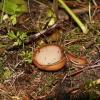
21-12-2025 09:32
Hello.A tiny ascomycete found embedded in wood in

21-12-2025 21:32
Pol DebaenstHello, Garden, Burgweg 19, Veurne, BelgiumOn 10/1

22-12-2025 23:38
Patrice TANCHAUDBonsoir, récolte sur un mur en pierre, apothéci

22-12-2025 00:47
Patrice TANCHAUDBonsoir, récolte à proximité du milieu dunaire

21-12-2025 21:40
Isabelle CharissouBonjour, j'aimerais connaitre les références de

20-12-2025 23:08
Patrice TANCHAUDBonsoir, récolte sur sol sablonneux dans l'arri�

20-12-2025 15:47
Mirek GrycHi.These grew on pine wood that was heavily covere
Three ascomycota from Finland
Stephen Martin Mifsud,
01-08-2015 12:29
 Hi, friends. I am currently in Finland and came accross three cup funghi which I wish to share with you, I have identified one as Humaria hemisphaerica but the others I had not much time to investigate and perhaps someone can save me some time if familiar with them :-)
Hi, friends. I am currently in Finland and came accross three cup funghi which I wish to share with you, I have identified one as Humaria hemisphaerica but the others I had not much time to investigate and perhaps someone can save me some time if familiar with them :-)
Lothar Krieglsteiner,
01-08-2015 18:39

Re : Three ascomycota from Finland
Hello Stephen,
I would agree with nr 1 Humaria hemisphaerica.
2 and 3 should be a Peziza. I assume it is acid soil there? Then both specimens could be P. badia. But it should be proved microscopically.
Regards from Lothar
Stephen Martin Mifsud,
01-08-2015 19:18

Re : Three ascomycota from Finland
Thank you Lothar.
The dark brown cups are Peziza badia, while I am still unsure about the third Peziza mainly because I do not remember that there was any dark-brown specimens; the cups where smaller (1-4cm); and the habitat was different, yes probably acidic too, but in sand/gravel shelves. Nevertheless I could go and check again. Unf. I have no microscope here in Finland.
The dark brown cups are Peziza badia, while I am still unsure about the third Peziza mainly because I do not remember that there was any dark-brown specimens; the cups where smaller (1-4cm); and the habitat was different, yes probably acidic too, but in sand/gravel shelves. Nevertheless I could go and check again. Unf. I have no microscope here in Finland.
Stephen Martin Mifsud,
10-08-2015 14:46

Re : Three ascomycota from Finland
Hi Lothar, I went to check these orange cups on sandy shore. Now they were dark-brown with a black rim. Some doubt remain because they are smaller than usual for P. badia and in a sandy habitat. However, I have access to a small microscope (Swift 3200) without any measurment possible, and I could notice small ascospores with two large circular, translucent oil bodies (both occupying c. 80-90% of internal volume) and an obvious rugose surface at x200. Unf. I couldn't use the x400 becasue I have no coverslips and I just mounted the section under two glass slides, hence too thick for the x400 objective.
Case is closed, both 2 and 3 are Peziza badia (=nothing interesting for most of you else distribution is up North in Jakobstad area, Finland).
Case is closed, both 2 and 3 are Peziza badia (=nothing interesting for most of you else distribution is up North in Jakobstad area, Finland).



